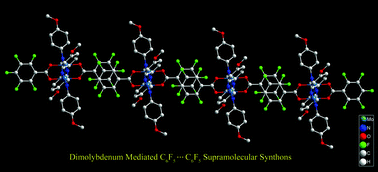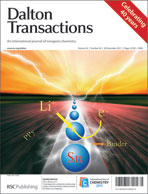Two supramolecular assemblies were developed by the dimmolybdenum paddlewheel complex trans-Mo2(DAniF)2(O2CC6F5)2 (1) (ancillary ligand DAniF = N,N′-di-(p-anisyl)formamidinate) through intermolecular offset face to face C6F5⋯C6F5 interactions. The two networks are different because of the presence and absence of tetrahydrofuran (THF) axial coordination to the Mo2 units, but feature commonly short interplanar distances between the two paired perfluorophenyl groups, that is, 3.30 Å and 3.23 Å, respectively, which are similar to the shortest intermolecular C⋯F contacts between two atoms in meta and ortho positions. Consistently, as indicated by the Mulliken population analysis, the dipole moments for the meta and ortho C–F bonds are considerably enlarged because the pentafluorobenzoate groups are bonded to the dimetal unit. In comparison, X-ray structural and theoretical analyses were also made for the parent molecule pentafluorobenzoic acid. The resultant data show that charge distribution on the perfluorophenyl group has a major influence on the C6F5⋯C6F5 binding mode. Therefore, it is evidenced that the dimetal unit plays a role in further polarizing the highly polarized C–F bonds and the intermolecular perfluorophenyl-perfluorophenyl interactions are dominated by the C⋯F dipole–dipole interaction, rather than aromatic-aromatic π–π stacking.

You have access to this article
 Please wait while we load your content...
Something went wrong. Try again?
Please wait while we load your content...
Something went wrong. Try again?


 Please wait while we load your content...
Please wait while we load your content...